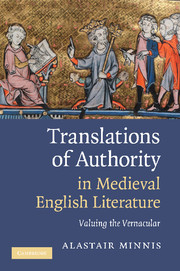Book contents
- Frontmatter
- Contents
- Preface
- List of abbreviations
- Introduction: valuing the vernacular
- Chapter 1 Absent glosses: the trouble with Middle English hermeneutics
- Chapter 2 Looking for a sign: the quest for Nominalism in Ricardian poetry
- Chapter 3 Piers's protean pardon: Langland on the letter and spirit of indulgences
- Chapter 4 Making bodies: confection and conception in Walter Brut's vernacular theology
- Chapter 5 Spiritualizing marriage: Margery Kempe's allegories of female authority
- Chapter 6 Chaucer and the relics of vernacular religion
- Notes
- Bibliography
- Index
Introduction: valuing the vernacular
Published online by Cambridge University Press: 30 June 2009
- Frontmatter
- Contents
- Preface
- List of abbreviations
- Introduction: valuing the vernacular
- Chapter 1 Absent glosses: the trouble with Middle English hermeneutics
- Chapter 2 Looking for a sign: the quest for Nominalism in Ricardian poetry
- Chapter 3 Piers's protean pardon: Langland on the letter and spirit of indulgences
- Chapter 4 Making bodies: confection and conception in Walter Brut's vernacular theology
- Chapter 5 Spiritualizing marriage: Margery Kempe's allegories of female authority
- Chapter 6 Chaucer and the relics of vernacular religion
- Notes
- Bibliography
- Index
Summary
Vulgo – ablativus ponitur adverbialiter – .i. ubique partout .i. quemunement, publiquement vel per vulgum .i. inordinate, incondite, vulgariter. Vulgaris et hoc .gare – .i. popularis, publicus, communis, manifestus .i. publiques, quemuns. Vulgariter – adverbium – populairement, publiquement. Vulgaritas .tatis – .i. popularitas, communitas vel publicatio, manifestatio … Vulgo .gas .gatum – .i. publicare, manifestare .i. publier, manifester. Vulgatus .a .um – .i. publicatus, manifestatus.
These definitions of terms relating to ‘vulgarity’ and the ‘vulgar’ are taken from the learned Latin–French dictionary which Firmin Le Ver compiled at the Carthusian house of St Honoré at Thuison, near Abbeville, in the first half of the fifteenth century. Public, popular, common, manifest … such are the concepts deemed crucial here. Publicus should be understood as appertaining to people in general (ad omnes generaliter), while popularis has the sense of ‘belonging to or fit for the common people’, ‘available to, directed towards the whole community, public’. Publicatio has the pre-print culture sense of the transmission of information into ‘a public sphere of discussion, debate, news, gossip, and rumour, in which things were generally spoken of and generally known’. The various ways in which these ideas were negotiated in different medieval European languages (in official, learned Latin and in demotic ‘vulgars’ or vernaculars) and in both ‘high’ and ‘low’ cultural situations, are the subject of this book.
- Type
- Chapter
- Information
- Translations of Authority in Medieval English LiteratureValuing the Vernacular, pp. 1 - 16Publisher: Cambridge University PressPrint publication year: 2009



